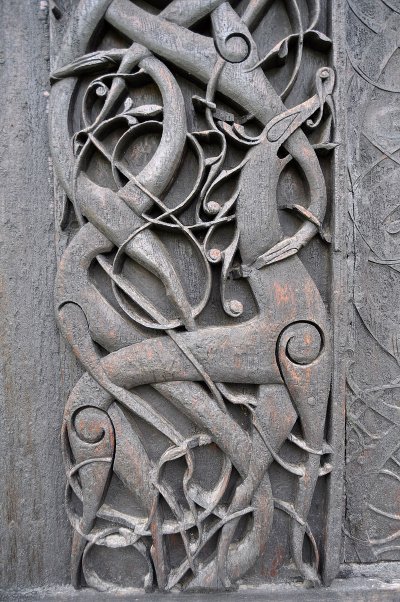Nidhogg – Dreadful Winged Corpse-Eating Dragon Who Is Enemy Of Asgard And Yggdrasil Tree
A. Sutherland - AncientPages.com - In Norse mythology, Nidhogg (also (Nithog, Nidhögg) is the corpse-eating dragon that lives entwined around Yggdrasil’s foot. Nidhogg is stalking in the roots of Yggdrasil.
In the Völuspá, a very powerful female shaman and seer, Völva, reveals that Nidhogg ("the Dread Biter") gnaws the roots of Yggdrasil; his evil deed symbolizes the destructive elements in the universe and this malevolent dragon is, in fact, the greatest threat to the tree of life.
Accompanied by his serpent sons (Goinn, Moinn, Grabakr, Grafvolludr, Ofnir, and Svafnir), Nidhogg gnaws the root of the sacred ash tree, threatening to destroy it.
It is Nidhogg’s plan to kill the tree because he knows that its death would be to signal the downfall of the gods.
Dwelling Place And Duties of Nidhogg
Nidhogg dwells in the spring Hvergelmir (‘Roaring Kettle’ or Roaring Cauldron), located in the center of Niflheim. From Hvergelmir flowed the eleven poisonous rivers that, with time, collapsed into the chasm, froze, and filled it with poisonous ice.
In “Gylfaginning”, Snorri Sturluson says that the place has a mythic past:
Nidhogg gnaws the roots of Yggdrasill in this illustration from a 17th-century Icelandic manuscript. Credit: Public Domain
“It was many ages before the earth was created, that Niflheim was made, and in the middle of it is the spring Hvergelmir, and from it flow those rivers that are so named: Svöl (Cool), Gunnthrá (Battle-pain), Fjörm (Rushing), Fimbulthul (Mighty-wind or Mighty-speaker), Slíd (Dangerous) and Hríd (Storm), Sylg (Slurp) and Ylg (She-wolf), Víd (Wide), Leipt (Flash)…”
Carving of Niddhog on a church in Norway. Credit: Public Domain
In addition to the killing of Yggdrasil, Nidhogg has also other tasks. In the vision told by a Völva, the dragon Nidhogg bears corpses on his wings:
“From below the dragon | dark comes forth,
Nithhogg flying | from Nithafjoll;
The bodies of men on | his wings he bears,
The serpent bright...”
The beast feeds on the blood from the bodies of losers and those unfortunate humans who were not allowed to enter Valhalla, a paradise for warriors.
Nidhogg will survive Ragnarok, the battle at the end of time between gods and men, giants, and monsters. It will survive the flood and the fire and harvest many new corpses of those guilty of murder, adultery, oath-breaking, and others who committed the worst possible crimes, according to Norse society’s law.
It is said after Ragnarok, Nidhogg will be bearing these corpses on his wings, from one of the worst regions in Niflheim, Nidafjoll located over the Nida Mountains.
Then, he will continue to suck blood from the bodies of the dead on Nastrond, the shore of corpses.
Credit: Adobe Stock - Inkling Design
In "Grimnesmol" (Grimnesmal), one of the mythological poems of the Poetic Edda, this dreadful creature is described as: “he who strikes with malice, with bitter enmity or spite”).
Interesting is also the origin of the name of this frightening mythological creature. The name Nidhogg is most probably derived from the word "níð", (in Old Norse: a loss of honor).
Is Nidhogg A Dragon Or A Snake?
Norse mythology has both dragons and snakes. Nidhogg, however, can be both. It is a snake, but it also has wings.
Like Jormungandr, a son of Loki, also Nidhogg is an enemy of the Aesir gods. During Ragnarok “the twilight of the gods”, the dragon will stand on the side of the giants under the leadership of Loki, and fight with Odin’s forces.
In Norse myths and legends, Nidhogg symbolizes chaos, sin, and destruction.
Updated on May 8, 2023
Written by – A. Sutherland AncientPages.com Staff Writer
Copyright © AncientPages.com All rights reserved. This material may not be published, broadcast, rewritten or redistributed in whole or part without the express written permission of AncientPages.com
Expand for references
More From Ancient Pages
-
 Ancient Artifacts With Puzzling Signs Found In North America May Be Evidence Of A Lost Civilization Or Unknown Native American Tribe
Featured Stories | Feb 4, 2025
Ancient Artifacts With Puzzling Signs Found In North America May Be Evidence Of A Lost Civilization Or Unknown Native American Tribe
Featured Stories | Feb 4, 2025 -
 Alexander The Great’s Biblical Connection
Featured Stories | May 29, 2019
Alexander The Great’s Biblical Connection
Featured Stories | May 29, 2019 -
 Unusual Discovery Of A Viking Age Phallic Stone In Tystberga, Sweden
Archaeology | Jun 12, 2023
Unusual Discovery Of A Viking Age Phallic Stone In Tystberga, Sweden
Archaeology | Jun 12, 2023 -
 Controversial 5,500-Year-Old Sumerian Star Map Of Ancient Nineveh Reveals Observation Of Köfels’ Impact Event
Artifacts | Dec 28, 2018
Controversial 5,500-Year-Old Sumerian Star Map Of Ancient Nineveh Reveals Observation Of Köfels’ Impact Event
Artifacts | Dec 28, 2018 -
 Pomegranate-Liked Seeds Found In Ancient Tomb Dated To Han Dynasty
Archaeology | Feb 22, 2017
Pomegranate-Liked Seeds Found In Ancient Tomb Dated To Han Dynasty
Archaeology | Feb 22, 2017 -
 Advanced Heating System Discovered In Ruins Of Metropolis ‘City Of Mother Goddess’
Archaeology | Nov 17, 2019
Advanced Heating System Discovered In Ruins Of Metropolis ‘City Of Mother Goddess’
Archaeology | Nov 17, 2019 -
 Mystery How Humans Lost Their Body Hair Solved By Scientists
Archaeology | Jan 4, 2023
Mystery How Humans Lost Their Body Hair Solved By Scientists
Archaeology | Jan 4, 2023 -
 The Legend Of Little Deer – Interesting Cherokee Tale Of How Disease And Medicine Began, And Why The Native Americans Respect All Life
Featured Stories | May 10, 2017
The Legend Of Little Deer – Interesting Cherokee Tale Of How Disease And Medicine Began, And Why The Native Americans Respect All Life
Featured Stories | May 10, 2017 -
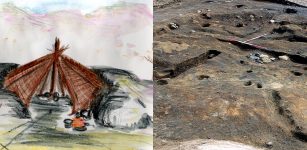 Stone Age People Lived In Reused Houses – Not Just Caves – Discovery In Norway Reveals
Archaeology | Jan 26, 2018
Stone Age People Lived In Reused Houses – Not Just Caves – Discovery In Norway Reveals
Archaeology | Jan 26, 2018 -
 Unexplained Ancient Encounters With Shining Beings Who Appeared Out Nowhere – Who Were They?
Featured Stories | Dec 15, 2024
Unexplained Ancient Encounters With Shining Beings Who Appeared Out Nowhere – Who Were They?
Featured Stories | Dec 15, 2024 -
 On This Day In History: British Forces Captured Gibraltar – On August 3, 1704
News | Aug 3, 2016
On This Day In History: British Forces Captured Gibraltar – On August 3, 1704
News | Aug 3, 2016 -
 Hundreds Of Undiscovered Roman Forts Revealed By Spy Satellites
Archaeology | Oct 27, 2023
Hundreds Of Undiscovered Roman Forts Revealed By Spy Satellites
Archaeology | Oct 27, 2023 -
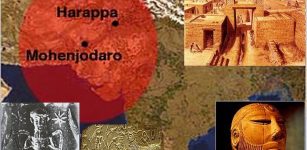 Indus Valley Civilization Far Ahead Of Its Time Has Baffled Scientists For Centuries
Ancient Technology | May 18, 2017
Indus Valley Civilization Far Ahead Of Its Time Has Baffled Scientists For Centuries
Ancient Technology | May 18, 2017 -
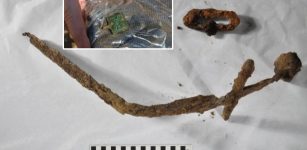 Crusader-Era Sword Discovered At Previously Unknown Burial Site In Finland
Archaeology | Oct 16, 2023
Crusader-Era Sword Discovered At Previously Unknown Burial Site In Finland
Archaeology | Oct 16, 2023 -
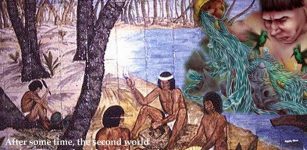 Creator God Kururumany Who Introduced Death Into The World And Deprived Humans Of Immortality
Featured Stories | Dec 19, 2016
Creator God Kururumany Who Introduced Death Into The World And Deprived Humans Of Immortality
Featured Stories | Dec 19, 2016 -
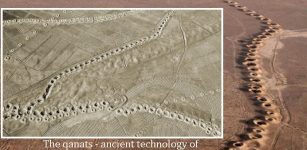 Qanats: Ancient 3,000-Year-Old Underground Irrigation Canals Invented By People Of Persia
Ancient Technology | Jul 13, 2020
Qanats: Ancient 3,000-Year-Old Underground Irrigation Canals Invented By People Of Persia
Ancient Technology | Jul 13, 2020 -
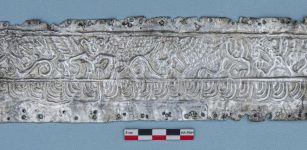 Unique Plate Of Winged Scythian Gods And Walking Griffons Discovered In Middle Don
Archaeology | Nov 19, 2021
Unique Plate Of Winged Scythian Gods And Walking Griffons Discovered In Middle Don
Archaeology | Nov 19, 2021 -
 Human DNA Shaped By Past Events Caused Sharp Dips In The Population
News | Jun 27, 2022
Human DNA Shaped By Past Events Caused Sharp Dips In The Population
News | Jun 27, 2022 -
 America’s First Civilization Was Made Up Of ‘Sophisticated’ Engineers – New Evidence
Archaeology | Sep 2, 2021
America’s First Civilization Was Made Up Of ‘Sophisticated’ Engineers – New Evidence
Archaeology | Sep 2, 2021 -
 Elk Tooth Rattlers And People’s Dance 8,000 Years Ago
Archaeology | Jun 4, 2021
Elk Tooth Rattlers And People’s Dance 8,000 Years Ago
Archaeology | Jun 4, 2021


